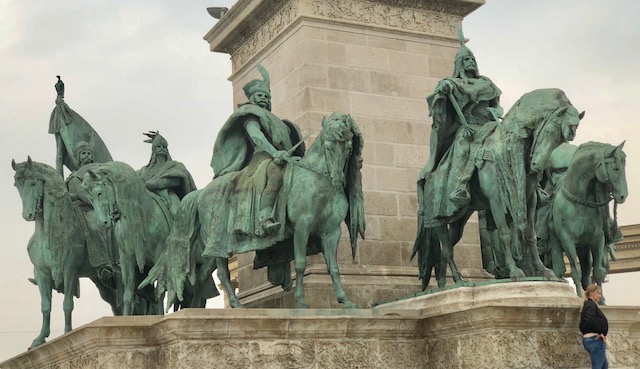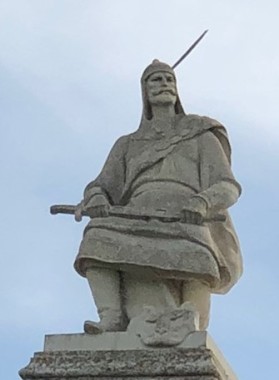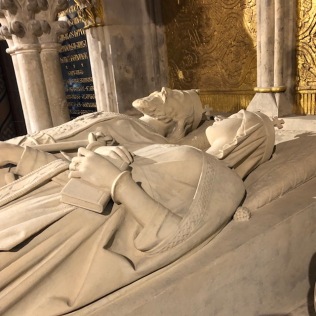
During my explorations of individuals in my family tree, I have often discovered several interesting characters. I have written about some of them in blog stories such as “My Ancestor the Witch,” a convicted Salem sorceress.
About 10 years ago while doing additional research in my mother’s family tree I surprisingly discovered some Hungarian heritage. While I am presently in Hungary, it has become very exciting to obtain more insight into this part of my family lineage from the National Museum and further Internet searches. Surprised once again, the lineage goes directly to the foundation of Hungary in 896 AD!
This story is about my adventures discovering memorials for Arpad, “First Prince of the Magyars” and memorials for Bela IV, King of Hungary, and one of Arpad’s 11th great grandsons.

To understand how I “fit in,” one must know a bit of Hungarian history. The “Magyars” are the more correct and official name for Hungarians. Following some initial explorations of the Carpathian Basin, they migrated there from the area near the Ural Mountains.
In 896, seven Magyar tribes viciously conquered the residents in the Basin, the location of present day Hungary and parts of several nearby countries. Hungarians identify this conquest as the birth of their nation.
The leader of the tribal chieftains was Arpad, “First Prince of the Hungarians.” Arpad (845-907) and a long line of Magyar monarchs (“Princes of the Hungarians” and “Kings of Hungary”) are descended from him. In my family tree, there are 14 generations of the Arpad dynasty monarchs beginning with Arpad, a 34th great-grandfather, and ending (in my tree) with Stephen V (1240-1272), a 22nd great-grandfather.
During the reigns of these monarchs through the Middle Ages there was always intrigue… wars, occupations, military exploits, royal family imprisonments, executions, and assassinations. In my family tree there are numerous instances where childhood marriages and marriage treaties were arranged with other royals across Europe. That is why I can find my mother’s ancestors in several countries including Portugal, Italy, and Spain, among others.

I have visited monuments to Arpad in Budapest at Heroes’ Square and in Ópusztaszer at the Ópusztaszer National Heritage Park (about two hours south of Budapest). At Heroes’ Square, a UNESCO World Heritage Site, one gets the feeling of the past grandeur of the nation.
Arpad along with the other chieftains on horses surround the base of the Millennial Monument constructed to celebrate Hungary’s 1000th anniversary in 1896.

The Ópusztaszer National Heritage Park is 136 acres and is said to be the location where Arpad and the other Magyar chieftains assembled to codify the laws to govern their new land. A park brochure explains that “it is the place where all Hungarians can turn to in order to strengthen their national identity, to remember and preserve their history, culture, and traditions.” Indeed this is a national favorite place to take school-age children as multiple busses filled with children on a field trip arrived during my visit.
The monument to Arpad and the surrounding busts of successive generations of the Arpad dynasty are central to the park along with a huge cyclorama depiction of conquering the lands and enslavement of the captives. Both the Arpad monument and the cyclorama were also presented in 1896, for the celebration of the founding conquest. There is much more at Ópusztaszer which I will describe in a subsequent story.
While taking photos of the Ópusztaszer Arpad Monument and several of the busts of descendant monarchs, a Hungarian man requested (through motions to his camera) that I take a photo of himself and his wife with the monument in the background. I didn’t understand Hungarian and he didn’t understand my interest in the monument but it was nice to be engaged with another person that way. “Who knows,” I thought to myself, “it could be possible we are distantly related.”
As Hungarian kings died, it became custom for their mortal remains to be placed in crypts in the Cathedral Basilica of Saint Stephen in Székesfehérvár. However, during the Ottoman Invasion in 1543, the crypts were desecrated and robbed. Somehow, Bela IV’s gravesite was overlooked. Years later, his gravesite was discovered intact and his remains were relocated to Matthias Church in Buda.

Prior to my first visit to Matthias Church I didn’t know that Bela IV’s crypt was there. Imagine my surprise to turn a corner to find the final resting place of my 23rd great-grandfather and his wife!
The exploration for my distant Hungarian relatives is one of those things that will continue as additional research will surely require many more explorations for them and others throughout Europe.




Amazing!!!
LikeLike
Very fascinating!
LikeLike
Absolutely amazing!!! Always brings a smile to my face, continue your journey of history and heritage
Anna
LikeLiked by 1 person